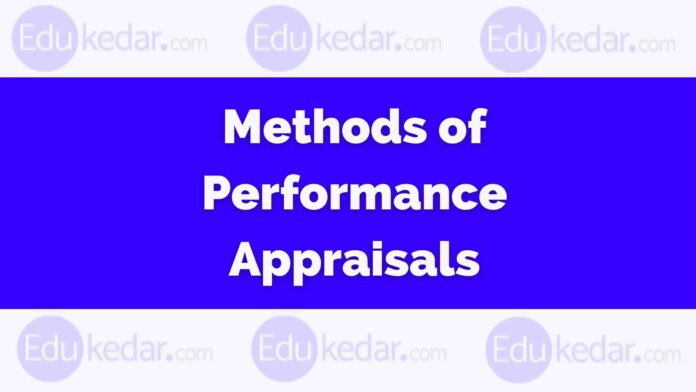One of the important responsibilities of a manager is to perform performance appraisal. Measuring the performance of an employee is a very difficult and technical process for a manager or HR department so to ease this problem they used different methods for performance appraisal.
In this article in detail, we will explain what is performance appraisal, what are the traditional and modern methods of performance appraisal and their advantage and disadvantage.
► What is Performance Appraisal?
Performance Appraisal is a systematic process through which an organization monitors reviews and measures an employee’s inputs or performance to the organization. This process is very crucial to evaluate an employee’s job knowledge, skills, ability, achievements, growth, and weakness.
► Methods of Performance Appraisal in HRM
Organizations used various performance appraisal methods to rate and measure the performance of their employees and set future goals for them. Current employees’ performance, as well as benefits and costs used on the employees. There are two broad categories of Performance Appraisal Methods.
- Traditional Methods of Performance Appraisal
- Modern Methods of Performance Appraisal
► Traditional Methods of Performance Appraisal
Traditional methods are the old way of performance measuring methods. These are based on personal qualities like knowledge, capacity, judgment, initiative, attitude, loyalty, leadership, judgment, etc.
- Ranking Method
- Confidential Report
- Forced distribution method
- Essay Appraisal
- Rating scale method
- Paired Comparison
- Checklist Method
- Critical Incidents Method
- Field review method
✔ 1. Ranking Method
The ranking method of performance appraisal is very common and widely used in organizations. In this method, managers will rank all the employees or subordinates in order of their perceived performance.
The ranking method of performance appraisal is quantitative only to the extent that a rank is a number. No points are given to employees based on their performance in this method.
◉ Advantages of the Ranking Method
- It helps in finding out the best performer.
- The ranking method is primarily comparative in nature so it is very useful for giving out awards such as employee of the month, quarter, or year.
◉ Disadvantages of the Ranking Method
- Managers may rank their favorite employees high rank.
- This method is totally based on the manager’s discretion.
- It can also create an atmosphere of animosity among employees and superiors.
- If all the employees under a particular manager have performed well, there might still be a few who have been ranked low because of the relative nature of this method.
✔ 2. Confidential Report
This is one of the traditional methods of performance appraisal, which is mostly used in government organizations As suggested by the name, Confidential Report System involves handing over the employee’s appraisal to senior-level management in sealed envelopes. These envelopes include their performance detail in a certain time frame. The height of confidentiality is that even the employee who is subject to the assessment is not allowed free access to the particular envelope. Only the authorized appraisal writer and senior management are allowed access to it.
Even though this method allows managers to be objective and candid about their employees, still, it is host to some limitations.
The confidential report is a traditional method of performance appraisal but is not generally used by private organizations. Most commonly, this method is used by public or governmental organizations.
◉ Advantages of Confidential Report
- Due to the secretive nature of performance appraisal.
- This method allows managers to be more open about employee strengths and weaknesses.
- It isn’t the best method of ensuring employee productivity.
◉ Disadvantages of Confidential Report
- This method of performance appraisal is very costly.
- This method is very subjective in nature and there is wide room for favoritism and business
- Employees do not see their ratings or predict their future incremental growth changes.
- Since employees do not have access to their performance information, it gets difficult for them to take corrective measures and improve their performance.
✔ 3. Forced Distribution Method
The forced distribution method is based on the assumption that employee performance level conforms to a normal statistical distribution or bell shape curve.
This method solves the problem of performance appraisal in which the rater rate the majority of the employee in the average categories. The forced distribution method forced the rater to rate the employees on all points on the rating scale.
◉ Advantages of Forced Distribution Method
- It removes the error of central tendency and leniency.
- It tells us who is the best performer and worst performer.
- It is best for large groups.
◉ Disadvantages of Forced Distribution Method
- It takes the false assumption of employees’ performance levels only conform to a bell-shaped curve.
- This method is failed when all employees have high-performance abilities.
- This method increases the chances of conflict or disagreement between managers and employees.
✔ 4. Essay Appraisal
This is a traditional and easiest method of performance appraisal in which a manager or superior compose an essay based on subordinate performance in the previous year.
In the essay, the manager writes about the employee’s skills, knowledge regarding the job, relationship with peers and seniors, the targets you achieved understanding of the company’s process, policies, and objectives, and how professional an employee has
◉ Advantages of Essay Appraisal
- It provides an overall analysis of employee performance.
- It also recommended what kind of job training employees required.
◉ Disadvantages of Essay Appraisal
- This method is only possible if superiors have good writing and analytical skills.
- Easy performance appraisal is that it is very subjective in nature.
- The essay method also depends on the memory power of the superior.
✔ 5. Rating Scale Method
It is a traditional method of performance appraisal of employees, and it is very popular among organizations.
This method used a rating scale generally ranging from poor to excellent or 1 to 5 points or 1 to 5 stars. The manager or rater rates the employee based on several different job-related parameters, such as initiative skill, behavior, dedication, punctuality, problem-solving ability, etc.
◉ Advantages of the Rating Scale Method
- It’s the simplest method and easy to understand.
- It is a low-cost and time-saving method.
- Every type of job is evaluated through this method.
- The rater does not require any training.
◉ Disadvantages of the Rating Scale Method
- Rater bias nature can affect employee performance appraisal.
- Many criteria are subjective in nature like employee behavior, and cooperation.
- This whole method is based on the criteria selected for performance appraisal. If rating real or overall job-related criteria are not covered by the survey then the organization does not reflect the true performance of employees.
✔ 6. Paired Comparison Method
The paired comparison method is a kind of traditional method in which employees can be ranked by the manager to determine whether every employee has performed better or worse than every other employee.
◉ Advantages of Paired Comparison Method
- It helps in finding the best performer.
◉ Disadvantages of Paired Comparison Method
- This method is significantly more complex and time-consuming.
- It can be challenging for a company to make decisions based on different rankings given by different managers.
- Depending on the relative rankings of the employees of a team.
✔ 7. Checklist Method of Performance Appraisal
In this method, a checklist of statements is based on the employee traits given to the rater, and the rater should tick in a “Yes” or “No” column.
it could also include particular statements and the manager would be required to answer it in the form of the extent to which they agree or disagree with it.
On the other side of the coin, this method has its own limitations. Its biggest drawback is that it’s not subjective enough to be efficiently applicable in corporate organizations.
◉ Advantages of the Checklist Method
- It is an economical method.
- The rater does not require much training.
- This method has easy to administer and stance.
Example. Yes No
1 Is the employee really interested in the job? …….. . ……..
2 Does the employee possess adequate knowledge about the job? ……….. ……….
✔ 8. Critical Incidents Method
This is one of the best traditional methods which focuses on the critical behavior of an employee. As per this method of performing this, a manager would write down the details of all the critical incidents that an employee is involved in or performs and this detailed collection of incidents help during the performance appraisal process.
◉ Advantages of Critical Incidents Method
- It evaluates the employee’s real job behavior.
- It motivates the employees to increase their performance because their manager is noticing them.
- It also reduces the recency bias because the manager notes all the key incident that shows the employee’s critical behavior.
◉ Disadvantages of Critical Incidents Method
- It is a very time-consuming and expensive process of performance appraisal
- It is very difficult for managers to witness every event and every task in which employees participate regularly.
- Critical behavior has no specific definition, therefore this method totally depends upon the manager’s perception of critical behavior.
✔ 9. Field Review Method of Performance Appraisal
This is an unconventional method of performance appraisal in which an outsider or member from the corporate office and HR department assess the employee performance.
The human resources department conduct these type of performance appraisal method to find or believe that a manager’s review is biased or inflated.
The HR department takes an interview with both employee and or their superiors and asks a set of predetermined questions to assess employees’ talents and abilities.
◉ Advantages of the Field Review Method
- With the help of this method, organizations get a complete assessment of employee performance.
- This method removes the superior biasedness or favoritism.
◉ Disadvantages of the Field Review Method
- Managers or superiors consider this process as a necessary interference of the HR in the matters of their team and department.
- This method is also very time-consuming and more costly than other methods.
- Many time HR department is not familiar with employee work, so it becomes very difficult to evaluate the performance of the employee.
- A short interview and short-term observation of employee performance can not reflect the genuine assessment of performance appraisal.
► Modern Methods of Performance Appraisal
Modern methods of performance appraisal use technology to measure performance. They are an advanced and more accurate method of measuring employee performance by improving the old and traditional methods.
The list of modern methods of performance appraisal is given below
- MBO (Management By Objective)
- BARS (Behaviorally Anchored Rating Scale)
- Assessment Centres
- 360-Degree Appraisal
- Cost Accounting Method
✔ 1. Management by Objectives (MBO)
Management by Objectives is the most used method for an individual’s performance evaluation. In this process, a specific task is assigned to the employee, through which an organization or job rater can assess an employee’s performance. The task which is assigned to an employee should be measurable, realistic, and achievable.
This method is commonly used in well-reputed organizations to measure the individual’s performance, however, this method is effective and less costly in contrast to other methods.
In a modern corporate business, management by objectives is one of the most common methods of performance appraisal. Management by objectives mainly consists of 4 steps to initiate the performance appraisal.
- In the First step, setting subordinate goals and objectives – employees are informed of the goals they are expected to fulfill.
- In the Second step, monitor and define standards or parameters – the parameters or standards on which the goals will be evaluated are determined.
- In the Third step, Evaluate the performance – In this step, the performance of employees to attain the goals is compared to the previously agreed goal standards. It helps employers to decide why these goals were met, not met, or exceeded.
- In the Fourth step, a periodic review is carried out – This is the last step in which managers and employees reporting to them discuss the employees’ development. The employees are informed of their shortcomings, strengths, and opportunities, enabling them to do better in the next stipulated period of time.
◉ Advantages of Management by Objectives (MBO)
- It also provides an accurate analysis of an individual’s outputs.
- It is result oriented approach.
- The role and responsibilities are clearly defined.
- Periodic review reports all strengths, weaknesses, and opportunities.
◉ Disadvantages of Management by Objectives (MBO)
- This method is also very time-consuming and more costly than other methods.
- Issues with goal setting process.
- It has a lack of flexibility related to goals.
Also Read : What is MBO? (in detail)
✔ 2. Behaviourally Anchored Rating Scale (BARS)
The behaviorally Anchored Rating Scale method is one of the modern methods to measure an individual’s performance. It measures the behavioral patterns of the individuals.
In the BARS method, the first manager notes the task that the employee performs and analyzes the employee’s behavior. After analyzing the employees’ behaviors rater rate the behavior with the help of a rating scales them explaining an individual trait. On the basis of an individual’s behavior, the rater rate the behavior as good, average, or poor.
◉ Advantages of Behaviourally Anchored Rating Scale (BARS)
- It provides comprehensive analysis so that employees know where improvement is required.
- It focuses on the behavioral requirement to perform this job.
- Rating scales have high accuracy.
◉ Disadvantages of the Behaviourally Anchored Rating Scale (BARS)
- It is a very costly method.
- It consumes a lot of time.
- It required the presence of a dedicated manager to observe the behavior of employees.
✔ 3. Assessment Center
In the assessment center approach, the employee’s current performance is observed or evaluated by the manager or rater through interviews, different tasks,s and activities.
In the assessment center method, an organization sets up a social simulation in which employees are asked to take part and rater judge the major competencies of individuals such as interpersonal skills, intellectual capability, planning and organizing capabilities, motivation, career orientation, etc. assessment centers are also an effective way to determine the training and development needs of the targeted employees.
◉ Advantages of Assessment Center
- It is used to determine the selection, training, and promotion of candidates.
- With the help of this method, candidates can find out their strengths and weakness.
- The candidates can improve their performance. They can increase their strengths and remove their weaknesses.
- It is more valid because the candidate is evaluated (judged) by many different experts
◉ Disadvantages of the Assessment Center
- This method is costly and it is slightly difficult to apply in all organizations.
- It is very time-consuming.
- Highly experienced managers are required to evaluate employee performance.
- The evaluators or rater may be biased.
- The candidates may not get proper feedback.
✔ 4. 360-Degree Appraisal
The 360-degree appraisal method is a systematic process of developing a comprehensive review of an employee’s performance. In this process, organizations take feedback or employee reviews from multiple people who have had an interaction with the employee.
It includes all employee team members, employee’s manager, employee’s juniors, and clients whom they worked with all taking part in appraisal. The assessment may be wholly quantitative or a mixture of quantitative and qualitative metrics.
After collecting feedback from every person who interacts with the employee, the human resources team and the senior management can build a realistic assessment of an employee’s performance.
◉ Advantages of 360-Degree Appraisal
- It provides a clear understanding of employee roles and responsibilities in the organization.
- It improves the productivity of the employee.
- Employees become self-aware of his/her strength and weakness.
- It increases transparency within the organization.
◉ Disadvantages of 360-Degree Appraisal
- It is a time-consuming method.
- It may provide a biased opinion.
- Collecting data from different source create too much data.
- There is a high chance that employees might discuss how they will review each other and give everyone great reviews in anticipation of similar reviews from others.
✔ 5. Cost Accounting Method
In this performance appraisal method, the focus is on how much profit an employee generated for the organization.
According to the cost accounting method of performance appraisal, the job rater or evaluator will measure the value of your contribution to the organization’s profit.
The decisions regarding an employee’s future, salary, promotion, and other considerations are solely based on the amount of profit or loss that the employee contributes to the organization.
- When nothing but costs and profits matter, it is hard for
- There is serious acrimony among employees, especially in businesses where client interactions are a daily feature of the job.
◉ Advantages of the Cost Accounting Method
- It helps the organization to accurately evaluate performance.
- Salary and benefits are proportional to employee contribution to the organization.
- It is a quantitative method.
◉ Disadvantages of the Cost Accounting Method
- This method is time-consuming.
- This method faces subjectivity problems.
- Organizations do not appreciate other salient features of employee performance personality, dedication, and hard work.
- This appraisal method can also lead to a toxic atmosphere within the company.





